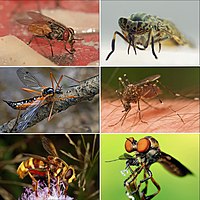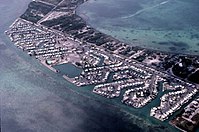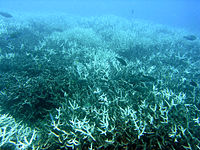
Satellite Image-Based Time Series Observations of Vegetation Response to Hurricane Irma in the Lower Florida Keys
Sign Up to like & getrecommendations! Published in 2020 at "Estuaries and Coasts"
DOI: 10.1007/s12237-020-00701-8
Abstract: High-resolution satellite imaging represents a potentially effective technique to monitor cyclone-caused environmental damage and recovery over large areas at a high spatial scale. This study utilized a 10-m resolution Sentinel satellite image series to document… read more here.
Keywords: florida keys; vegetation; series; satellite image ... See more keywords

Eudesmacarbonate, a Eudesmane-Type Sesquiterpene from a Marine Filamentous Cyanobacterial Mat (Oscillatoriales) in the Florida Keys.
Sign Up to like & getrecommendations! Published in 2020 at "Journal of natural products"
DOI: 10.1021/acs.jnatprod.0c00203
Abstract: A new, cyclic carbonate eudesmane-type sesquiterpene, eudesmacarbonate (1), was isolated from marine filamentous cyanobacterial mats associated with apparent ingestion-related intoxications of captive bottlenose dolphins in the Florida Keys. Sequencing of 16S rDNA revealed that mats… read more here.
Keywords: filamentous cyanobacterial; eudesmane type; florida keys; marine filamentous ... See more keywords

Quantifying the fragility of coral reefs to hurricane impacts: a case study of the Florida Keys and Puerto Rico
Sign Up to like & getrecommendations! Published in 2023 at "Environmental Research Letters"
DOI: 10.1088/1748-9326/acb451
Abstract: Ecosystems like coral reefs mitigate rising coastal flood risks, but investments into their conservation remain low relative to the investments into engineered risk-mitigation structures. One reason is that quantifying the risk-reduction benefits of coral reefs… read more here.
Keywords: keys puerto; florida keys; coral reefs; hurricane ... See more keywords

Human Blood Feeding by Aedes aegypti (Diptera: Culicidae) in the Florida Keys and a Review of the Literature
Sign Up to like & getrecommendations! Published in 2020 at "Journal of Medical Entomology"
DOI: 10.1093/jme/tjaa083
Abstract: Abstract Aedes aegypti L. is considered to have a proclivity for feeding on human blood even when other hosts are available. However, few studies have demonstrated host use by this mosquito in the continental United… read more here.
Keywords: aedes aegypti; diptera culicidae; florida keys; human blood ... See more keywords

Molecular Characterization of the 2016 New World Screwworm (Diptera: Calliphoridae) Outbreak in the Florida Keys
Sign Up to like & getrecommendations! Published in 2018 at "Journal of Medical Entomology"
DOI: 10.1093/jme/tjy078
Abstract: Abstract New World screwworm (NWS), Cochliomyia hominivorax (Coquerel 1858) (Diptera: Calliphoridae), is a myiasis-causing fly that can be a serious threat to the health of livestock, wildlife, and humans. Its progressive eradication from the southern… read more here.
Keywords: new world; source; florida keys; diptera calliphoridae ... See more keywords

Species‐specific responses to climate change and community composition determine future calcification rates of Florida Keys reefs
Sign Up to like & getrecommendations! Published in 2017 at "Global Change Biology"
DOI: 10.1111/gcb.13481
Abstract: Anthropogenic climate change compromises reef growth as a result of increasing temperatures and ocean acidification. Scleractinian corals vary in their sensitivity to these variables, suggesting species composition will influence how reef communities respond to future… read more here.
Keywords: change; community; florida keys; calcification ... See more keywords

Environmental specialization and cryptic genetic divergence in two massive coral species from the Florida Keys Reef Tract
Sign Up to like & getrecommendations! Published in 2021 at "Molecular Ecology"
DOI: 10.1111/mec.15931
Abstract: Broadcast‐spawning coral species have wide geographical ranges spanning strong environmental gradients, but it is unclear how much spatially varying selection these gradients actually impose. Strong divergent selection might present a considerable barrier for demographic exchange… read more here.
Keywords: keys reef; species florida; reef tract; florida keys ... See more keywords

Distribution of cephalopod paralarvae across the Florida Current front in the Florida Keys: preliminary results
Sign Up to like & getrecommendations! Published in 2017 at "Revista De Biologia Tropical"
DOI: 10.15517/rbt.v41i1.29276
Abstract: In this communication I present the preliminary results of a study which will quantitatively describe the paralarval cephalopod as semblages across the FC front off the Florida Keys utilizing multivariate data. Results of this work… read more here.
Keywords: current front; front; florida keys; florida current ... See more keywords

Legume-Feeding Lepidoptera of the Florida Keys: Potential Competitors of an Endangered Lycaenid Butterfly
Sign Up to like & getrecommendations! Published in 2020 at "Florida Entomologist"
DOI: 10.1653/024.103.0308
Abstract: Abstract Two Fabaceae in the Florida Keys, Pithecellobium keyense Coker and Guilandina bonduc Griseb., have been of interest because they are the larval host plants for the endangered Miami blue butterfly (Cyclargus thomasi bethunebakeri [Comstock… read more here.
Keywords: legume feeding; feeding lepidoptera; butterfly; florida keys ... See more keywords

Combining revealed and stated preference models for artificial reef siting: A study in the Florida Keys.
Sign Up to like & getrecommendations! Published in 2022 at "Journal of environmental management"
DOI: 10.2139/ssrn.4127241
Abstract: This paper investigates divers' preferences for artificial reef diving and willingness to pay (WTP) for large ship, artificial reef site attributes in the Florida Keys. We investigate diver demand for existing decommissioned ships that have… read more here.
Keywords: artificial reef; florida keys; stated preference; combining revealed ... See more keywords

Twenty-year record of white pox disease in the Florida Keys: importance of environmental risk factors as drivers of coral health.
Sign Up to like & getrecommendations! Published in 2023 at "Diseases of aquatic organisms"
DOI: 10.3354/dao03727
Abstract: Declining coral populations worldwide place a special premium on identifying risks and drivers that precipitate these declines. Understanding the relationship between disease outbreaks and their drivers can help to anticipate when the risk of a… read more here.
Keywords: florida keys; pox disease; disease; risk ... See more keywords